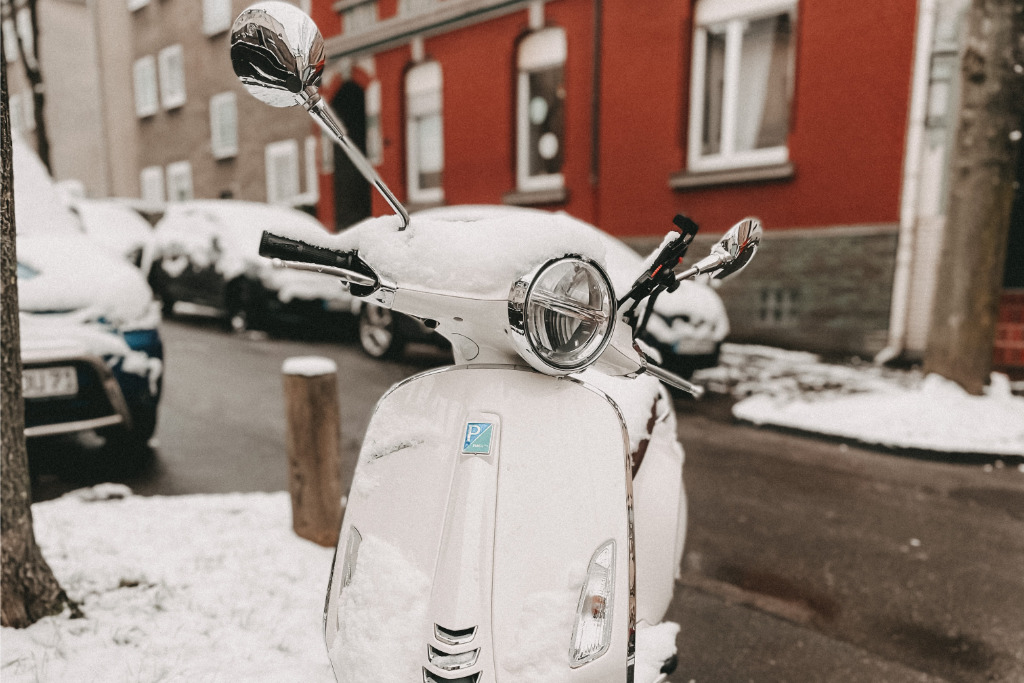Winter is approaching and usually faster than expected. Man knows what to do in cold temperatures. Very few then run around in sandals, T-shirt and shorts. The same applies to the Vespa. Also this good piece must be prepared for the winter to survive the cold season well to be ready to start again next spring.
Starting problems after the winter break are not uncommon. For this reason, the Vespa or the scooter should be winterized sensibly. Of course, this does not mean that it is not possible to use the Vespa in winter. On the contrary, driving Vespa in winter can bring a lot of fun, provided that the weather is dry. However, it is important to remember that salt from previous gritting trips will still be on the roads and stick to the metal and rubber. Thorough cleaning after the ride is therefore essential.
A common problem in the wintertime is rust. To prevent the vehicle from rusting during the usually quite long winter break, the scooter should be thoroughly washed before winterization. Especially the bottom plate is a popular place for rust to accumulate. Here often remains some dirt, which binds the humidity longer and thus provides for rust. If there are already scratches that reach down to the sheet metal, these should be dabbed with paint. If no paint is available, anti-corrosion oil can also be used here.
Before the beloved scooter begins its well-deserved winter sleep, it should not be neglected to winterize the Vespa. In doing so, it is important to note a few points.
1. Cleaning and chrome care
Stains and insect dirt are poison for the moped. Therefore, they should be thoroughly washed off before winter storage begins. All parts made of chrome should be polished again. Of course, care products may be used in the process.
2. Full battery
To charge the battery, it must normally be disconnected. Various chargers make things easier. With these, the battery does not have to be disconnected and is automatically recharged as required.
3. Radiator
Even if the vehicle is in the garage, it gets icy cold. The radiator level should therefore be checked. It is also advisable to top up the antifreeze now.
4. Air pressure on the tires
The winter check of the Vespa also includes checking the pressure of the tires. A flat tire is something that can be dispensed with. This can be done by now increasing the pressure by about 0.3 bar.
5. A full tank
The tank is usually made of metal and is therefore a component that can rust. To avoid this, it should be full of gasoline.
6. Winter storage
With the help of parking trolleys, the scooter can be jacked up during winter storage. However, it is also sufficient to place it on the main stand. It is only important that the tires are relieved. For particularly gentle winter storage, it is advisable to park the scooter in a cellar or garage. If there is no such possibility, a scooter cover will also do, with which the scooter is well protected.
7. Winter tires
Dry and sunny winter weather is sometimes also tempting for a spin on the scooter. However, it is essential to have the right winter tires.
Important: Winter tires are no longer mandatory for scooters in Germany since 2017. Nevertheless, it should not be dispensed with under any circumstances. In Switzerland and Austria, however, winter tires are still a must.
8. Never freeze
Not only the scooter should be well cared for in winter. The person should also feel comfortable in cold temperatures. Practical and stylish at the same time is the clothing of Tucano Urbano. Against wetness and cold, no matter what season, the wind and weather protection “Termoscud®” protects perfectly. The special feature: The blanket can be connected to the scooter with very little effort. This keeps legs and lower body snug and warm. For additional protection against the cold, the coat under the padded and waterproof surface.
Hands should also be protected against cold, especially in winter and in bad weather. The safest and warmest solution here are the grip cuffs from Tucano Urbano.
Often only a short ride is planned in cold and wet conditions. With the “Linuscud” from Tucano Urbano the firm connection with the scooter is missing, but legs, chest and hips are still protected from cold and wet.
If the “Termoscud” is too bulky, the “Panta-Fast” will do. This is also not firmly attached to the scooter. It is hung around like an apron and can also be used as additional protection in bad weather.
The flip side also likes it cozy and warm. The Tucano Urbano seat heater helps with this. Secure Velcro straps provide a firm hold for the heated pad.
Fast and reliable protection against the cold and wet is guaranteed by the “Cool Hot” thermal skirt from Tucano Urbano. Quick on and off, secure protection and sufficient freedom of movement make the “Cool Hot” a popular companion.
When the riders have it nice and warm, the passengers should also be thought of. The “Termoscud® Passenger” weather protection from Tucano Urbano makes the ride warm and dry for the pillion passenger as well. Thanks to a Velcro fastener, it is simply attached to the rider’s “Termoscud” or placed around the waist.
9. Light saves lives
It gets light late and dark early, sometimes it doesn’t really get light at all. All the more important now is the scooter lighting. Therefore, the lighting should be checked and replaced if necessary. It is also recommended to convert only weak 6 volt ignitions, to more powerful 12 volt 110 watt SIP Performance ignitions.



Comments (1)